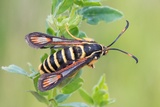Bembecia ichneumoniformis ([Denis & Schiffermüller], 1775) Species
Last modified: Nov. 21, 2025, 7:19 p.m.
This sole representative of the genus Bembecia is not a rare species in Belgium. And it looks like it expanded its distribution considerably since the beginning of the 21st century.
This species is considered Least Concern according to the IUCN Red List category for Flanders 2023.
Details
- Classification
- Family: Sesiidae > Subfamily: Sesiinae > Tribus: Synanthedonini > Genus: Bembecia > Species: Bembecia ichneumoniformis
- Vernacular names
- Klaverwespvlinder (NL), Six-belted Clearwing (EN), Sésie ichneumon (FR), Hornklee-Glasflügler (DE)
- First mention in Belgium
- De Sélys-Longchamps E. 1837. Catalogue des Lépidoptères ou Papillons de la Belgique, précédé du tableau des Libellulines de ce pays. — — : 1–29. On page 21 (as Sesia Ichneumoniformis). view page
- Status
-
Native
Distribution
Imago
B. ichneumoniformis is, on average, a fairly large species (12–28 mm) but varies quite a bit in size. The females are often considerably larger than the males. In the latter, the antennae are predominantly black with sometimes some orange scales distally while those of the female are ochreous-orange with a black apex. The apical area of the forewings has orange scales between the dark-brown veins and the discoidal spot is orange with proximally a black delineation having a wedge pointing inwards. The abdomen has yellow bands –all of equal width– on all segments. Only the band on the fifth segment is sometimes narrower or even absent. In the male, the anal tuft is black laterally with yellow hair-like scales in the middle while in the female the anal tuft has a mainly yellow aspect formed by two yellow triangles pointing to each other. The proboscis is, as in all species of this genus, rudimentary and thus non-functional. The males are very well attracted to the pheromone developed for this species (which is identical to the composition used to lure Ch. empiformis) and are best attracted before noon although there are often specimens still observed in the afternoon. Also for this species the optimal time window is weather dependent.
Egg
The elliptically shaped egg is black.
Cocoon/pupa
The caterpillar does not construct a cocoon but a tube, made of gnawed material from the root of the host plant spun together. The pupation takes place at the lower part of this tube with at the distal end a trapdoor-like barrier. The pupa itself is yellow-brown.
Bionomics
The eggs are deposited on a stalk, the underside of a leaf or on a flower of the hostplant. The young larvae hatch after about one week and, after some time, they bore into the plant and tunnel towards the root. Adult larvae mostly live inside the main root but in larger plants their presence is often not noticeable externally. Occasionally, part of the plant turns yellow or wilts and dries. In young plants with small roots, the caterpillar often lives at the outside of the root in an abutting kind of tube. Wintering takes place in a loosely spun hibernaculum. The adult larva constructs a tube that is mostly short but can be of a considerable length if the circumstances require it.
The pupation takes place at the lower part of this tube and, at the distal end, the larva constructs a trapdoor-like occlusion. On hatching the pupa breaks through this seal and subsequently through the top of the tube. Hence, the development of this species completes in one year.
Flight periods
The adults fly from early June till mid-August but the main flight period is June–July.
Observed on
- Host plant (species):
- Anthyllis vulneraria and Lotus corniculatus
- Host plant (genera):
- Lotus and Hippocrepis
The larva bores into the rootstock of –mainly– Lotus corniculatus but also a lot of other Fabaceae such as Anthyllis vulneraria and Hippocrepis spp. are accepted as hostplant.
Habitat
This species prefers xerothermic, sunny and treeless areas. Roadsides, edges of quarries and dumping grounds often offer excellent biotopes.



















